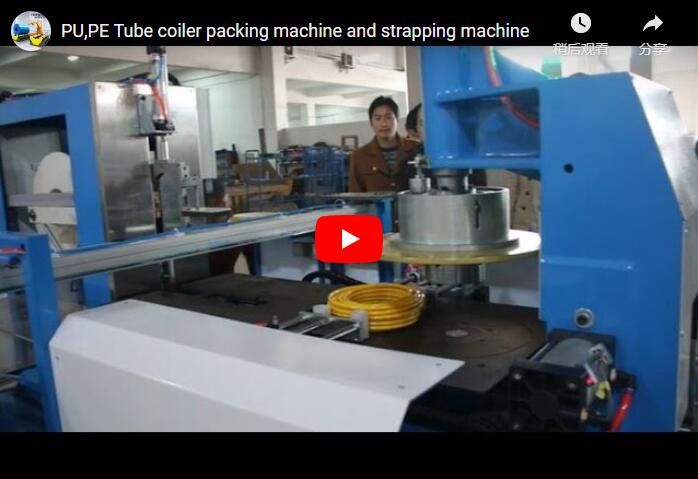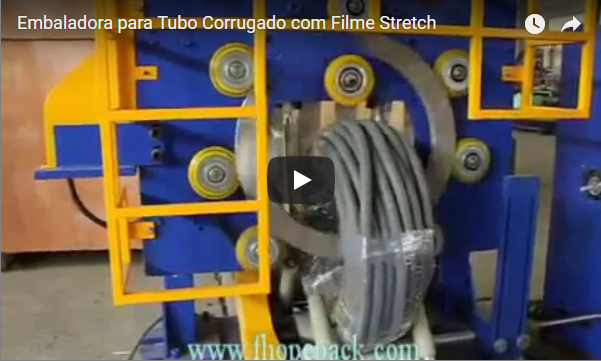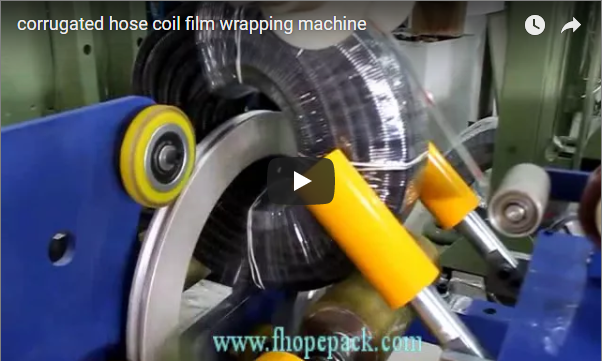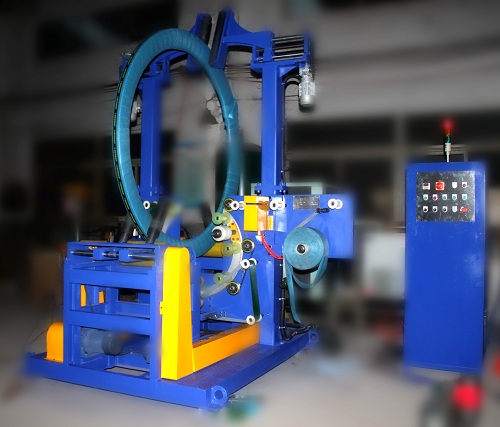Technical Deep Dive: Automated Coil Wrapping Machine with Integrated Side Tape Applicator for Enhanced Efficiency and Branding
In the demanding world of metal processing and manufacturing, the secure, efficient, and well-presented packaging of coils – whether steel, copper, aluminum, or wire – is not just a necessity, but a competitive advantage. Moving beyond manual limitations, this article explores the technical intricacies, operational benefits, and strategic value of an advanced automatic coil wrapping machine integrated with a precision side tape applicator, as showcased in the video above.
1. The Evolving Demands of Industrial Coil Packaging
Traditional coil handling and packaging methods often fall short in today's fast-paced, quality-focused industrial environment. Key challenges include:
- Inconsistent Protection: Manual wrapping can lead to variable tension and coverage, increasing the risk of damage from handling, moisture, or contaminants during storage and transit.
- Operational Bottlenecks: Manual processes are labor-intensive, slower, and can hinder overall production throughput.
- Missed Branding Opportunities: Standard packaging offers little scope for incorporating brand identity directly onto the primary wrap.
- Safety Hazards: Manually handling heavy, potentially sharp-edged coils poses significant ergonomic risks.
Addressing these pain points through automation is essential for optimizing costs, ensuring product integrity, enhancing safety, and leveraging packaging as a branding tool. Industry analysis, such as insights often shared in publications like Modern Materials Handling, consistently underscores the significant return on investment (ROI) achievable through end-of-line packaging automation.
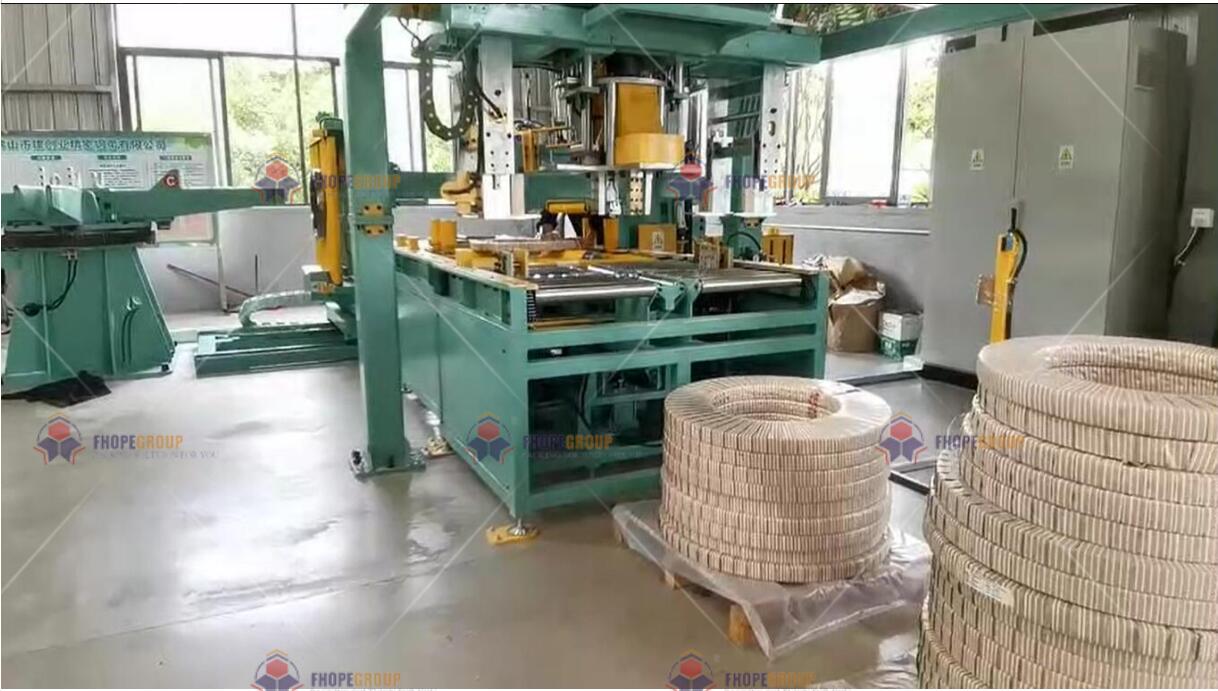
2. Solution Overview: Automated Wrapping Meets Precision Taping
The machine detailed here represents a sophisticated leap in coil packing technology. It synergizes the robust protection of through-eye orbital wrapping with the branding and sealing capabilities of automated side tape application, offering a comprehensive solution engineered for performance and versatility.
3. Design & Core Components Breakdown
Understanding the machine's structure provides insight into its capabilities:
- Orbital Wrapping Ring Assembly: The heart of the machine, this high-speed ring carries the wrapping material (e.g., stretch film, VCI paper) dispenser. Its precise rotation and vertical movement ensure complete, overlapping coverage around the coil's circumference and through its eye.
- Film/Paper Delivery System: Features include automated material cutting and clamping, adjustable tension control, and often a powered pre-stretch mechanism (for stretch film) to optimize material usage (typically achieving 200-300% stretch) and secure the load effectively.
- Side Tape Application Module: This specialized unit precisely applies adhesive tape (like printed BOPP, PVC, or functional tapes) to one or both side faces of the coil. Key design aspects include accurate tape placement sensors, cutting mechanisms, and adjustable positioning to accommodate different coil widths and taping requirements.
- Conveyor and Handling System: Robust roller or chain conveyors manage the infeed, positioning (often with rotation for taping), and outfeed of coils. Sensors detect coil presence, diameter, and width to automate the sequence.
- Control System & HMI: Typically built around a reliable PLC (Programmable Logic Controller) (e.g., Siemens, Allen-Bradley), coupled with a user-friendly touchscreen HMI. This allows operators to easily set parameters, select recipes for different coil types, monitor the process, and perform diagnostics.
- Safety Features: Comprehensive safety measures are integral, including light curtains, safety interlocks on access doors, emergency stop buttons, and physical guarding, complying with international safety standards (e.g., CE, ISO).
4. Operational Workflow: Step-by-Step Automation
The machine executes a seamless, automated sequence:
- Coil Infeed & Sensing: The coil arrives on the infeed conveyor. Sensors accurately detect its arrival and measure key dimensions (OD, ID, Width) to trigger the correct pre-programmed wrapping and taping recipe.
- Positioning & Rotation: The coil is precisely positioned in the wrapping zone. If side taping is required on both faces, a rotation mechanism may turn the coil partway through the cycle.
- Through-Eye Wrapping: The orbital ring begins wrapping, applying the chosen material (e.g., stretch film, VCI paper) with controlled overlap and tension. The number of layers and wrapping pattern are defined by the selected recipe.
- Side Tape Application: Synchronized with or following the wrapping, the side tape applicator(s) deploy, applying the adhesive tape accurately onto the designated side surface(s). The system ensures correct tension, cut-off, and adhesion.
- Material Cut & Seal: Upon cycle completion, the wrapping material and tape are automatically cut and secured (e.g., wiped down).
- Coil Outfeed: The fully wrapped and taped coil is smoothly transferred onto the outfeed conveyor, ready for the next stage (palletizing, weighing, labeling, shipping).
5. Key Technical Specifications & Customization
While specific parameters vary by model and customization, typical specifications include:
- Coil Dimensions Handling:
- Outer Diameter (OD): 500mm - 2000mm (example range, customizable)
- Inner Diameter (ID): 300mm - 1500mm (example range, customizable)
- Width: 50mm - 800mm (example range, customizable)
- Coil Weight Capacity: 100kg - 5000kg+ (model dependent)
- Wrapping Material Specs:
- Type: LLDPE Stretch Film, VCI Paper, HDPE, Woven Belt etc.
- Film/Paper Width: 76mm / 90mm / 120mm (customizable)
- Roll Outer Diameter: Up to 500mm (customizable)
- Tape Applicator Specs:
- Tape Type: BOPP (logo/plain), PVC, Cloth Tape, Selvedge Tape
- Tape Width: 48mm - 76mm (common range)
- Roll Outer Diameter: Up to 300mm
- Performance:
- Wrapping Ring Speed: 30 - 90 RPM (adjustable)
- Packing Speed: 20-60 Coils/hour (depends on coil size & wrapping layers)
- Control System: PLC + Touchscreen HMI (Recipe storage, diagnostics)
- Power Requirements: Typically 380V/50Hz/3Ph or specified
- Compressed Air: 0.5 - 0.7 MPa (if pneumatic components used)
6. Operational & Maintenance Considerations
From an operator's perspective, modern automated systems offer significant advantages:
- Ease of Use: Intuitive HMIs allow for quick recipe selection, parameter adjustments (overlap rate, tension, tape position), and clear visualization of the machine status. Password-protected levels ensure operational integrity.
- Routine Maintenance: Generally involves regular checks of moving parts (chains, bearings), sensor cleaning, blade sharpness inspection, and replenishment of consumables (film, tape). HMIs often include maintenance schedule reminders.
- Troubleshooting: Integrated diagnostics within the PLC/HMI system help pinpoint issues quickly, minimizing downtime. Remote access capabilities may be available for manufacturer support.
- Material Loading: Designed for relatively quick and easy loading of wrapping material and tape rolls.
7. Measurable Benefits & Strategic Impact
Investing in this automated coil wrapping machine translates to tangible advantages:
- Superior Product Protection: Consistent, tight wrapping significantly reduces scratches, corrosion (especially with VCI materials), and contamination, cutting down potential damage claims.
- Drastic Efficiency Gains: Automation dramatically increases packaging speed (often 2-5x faster than manual methods) and reduces labor dependency, freeing up personnel for higher-value tasks. Throughput increases directly impact profitability.
- Enhanced Branding & Professionalism: Applying branded tape directly during wrapping elevates product presentation, reinforces brand identity at every touchpoint, and adds a layer of tamper evidence.
- Improved Workplace Safety: Eliminates manual lifting and handling of heavy coils during the wrapping process, significantly reducing ergonomic injuries.
- Optimized Material Consumption: Precise control over film stretch and overlap, plus accurate tape usage, minimizes waste compared to manual application, leading to direct cost savings.
- Unwavering Consistency: Every coil receives the same high-quality packaging, ensuring adherence to quality standards and boosting customer satisfaction.
8. Integrating with Your Production Line
These machines are designed for seamless integration into existing production flows. They can receive coils directly from slitters or annealing lines and feed wrapped coils to automated guided vehicles (AGVs), robotic palletizers, or strapping stations. Connectivity options often include Ethernet/IP, Profinet, or other standard protocols for communication with plant-level Manufacturing Execution Systems (MES) or Warehouse Management Systems (WMS), enabling real-time tracking and data exchange vital for Industry 4.0 initiatives.
9. Conclusion: Investing in Advanced Coil Packaging Technology
The Automatic Coil Wrapping Machine with Integrated Side Tape Applicator is far more than just a packaging machine; it is a strategic investment in operational excellence, product integrity, and brand enhancement. By delivering superior protection, remarkable efficiency, enhanced safety, and integrated branding, this technology provides a robust solution for manufacturers and processors handling diverse coil types. In a competitive global market, embracing such advanced automation is key to optimizing the supply chain, reducing costs, and delivering value – ensuring products arrive securely and professionally presented, every time.

